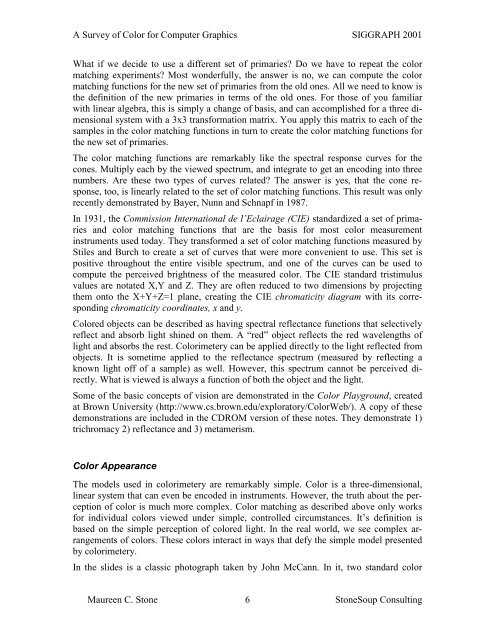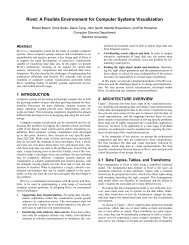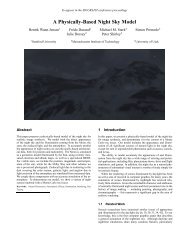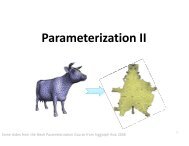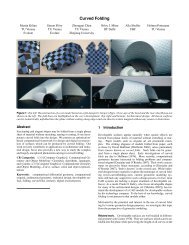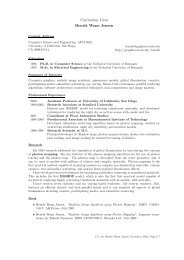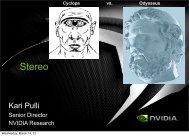A Survey of Color for Computer Graphics
A Survey of Color for Computer Graphics
A Survey of Color for Computer Graphics
Create successful ePaper yourself
Turn your PDF publications into a flip-book with our unique Google optimized e-Paper software.
A <strong>Survey</strong> <strong>of</strong> <strong>Color</strong> <strong>for</strong> <strong>Computer</strong> <strong>Graphics</strong> SIGGRAPH 2001<br />
What if we decide to use a different set <strong>of</strong> primaries? Do we have to repeat the color<br />
matching experiments? Most wonderfully, the answer is no, we can compute the color<br />
matching functions <strong>for</strong> the new set <strong>of</strong> primaries from the old ones. All we need to know is<br />
the definition <strong>of</strong> the new primaries in terms <strong>of</strong> the old ones. For those <strong>of</strong> you familiar<br />
with linear algebra, this is simply a change <strong>of</strong> basis, and can accomplished <strong>for</strong> a three dimensional<br />
system with a 3x3 trans<strong>for</strong>mation matrix. You apply this matrix to each <strong>of</strong> the<br />
samples in the color matching functions in turn to create the color matching functions <strong>for</strong><br />
the new set <strong>of</strong> primaries.<br />
The color matching functions are remarkably like the spectral response curves <strong>for</strong> the<br />
cones. Multiply each by the viewed spectrum, and integrate to get an encoding into three<br />
numbers. Are these two types <strong>of</strong> curves related? The answer is yes, that the cone response,<br />
too, is linearly related to the set <strong>of</strong> color matching functions. This result was only<br />
recently demonstrated by Bayer, Nunn and Schnapf in 1987.<br />
In 1931, the Commission International de l’Eclairage (CIE) standardized a set <strong>of</strong> primaries<br />
and color matching functions that are the basis <strong>for</strong> most color measurement<br />
instruments used today. They trans<strong>for</strong>med a set <strong>of</strong> color matching functions measured by<br />
Stiles and Burch to create a set <strong>of</strong> curves that were more convenient to use. This set is<br />
positive throughout the entire visible spectrum, and one <strong>of</strong> the curves can be used to<br />
compute the perceived brightness <strong>of</strong> the measured color. The CIE standard tristimulus<br />
values are notated X,Y and Z. They are <strong>of</strong>ten reduced to two dimensions by projecting<br />
them onto the X+Y+Z=1 plane, creating the CIE chromaticity diagram with its corresponding<br />
chromaticity coordinates, x and y.<br />
<strong>Color</strong>ed objects can be described as having spectral reflectance functions that selectively<br />
reflect and absorb light shined on them. A “red” object reflects the red wavelengths <strong>of</strong><br />
light and absorbs the rest. <strong>Color</strong>imetery can be applied directly to the light reflected from<br />
objects. It is sometime applied to the reflectance spectrum (measured by reflecting a<br />
known light <strong>of</strong>f <strong>of</strong> a sample) as well. However, this spectrum cannot be perceived directly.<br />
What is viewed is always a function <strong>of</strong> both the object and the light.<br />
Some <strong>of</strong> the basic concepts <strong>of</strong> vision are demonstrated in the <strong>Color</strong> Playground, created<br />
at Brown University (http://www.cs.brown.edu/exploratory/<strong>Color</strong>Web/). A copy <strong>of</strong> these<br />
demonstrations are included in the CDROM version <strong>of</strong> these notes. They demonstrate 1)<br />
trichromacy 2) reflectance and 3) metamerism.<br />
<strong>Color</strong> Appearance<br />
The models used in colorimetery are remarkably simple. <strong>Color</strong> is a three-dimensional,<br />
linear system that can even be encoded in instruments. However, the truth about the perception<br />
<strong>of</strong> color is much more complex. <strong>Color</strong> matching as described above only works<br />
<strong>for</strong> individual colors viewed under simple, controlled circumstances. It’s definition is<br />
based on the simple perception <strong>of</strong> colored light. In the real world, we see complex arrangements<br />
<strong>of</strong> colors. These colors interact in ways that defy the simple model presented<br />
by colorimetery.<br />
In the slides is a classic photograph taken by John McCann. In it, two standard color<br />
Maureen C. Stone 6<br />
StoneSoup Consulting


